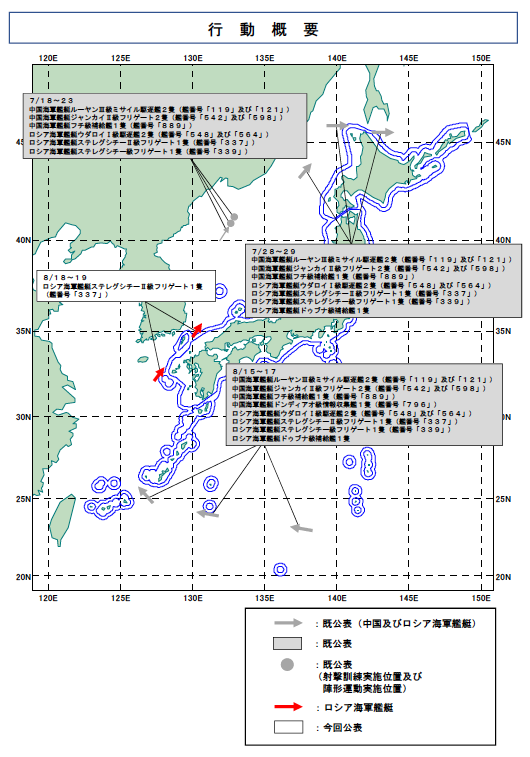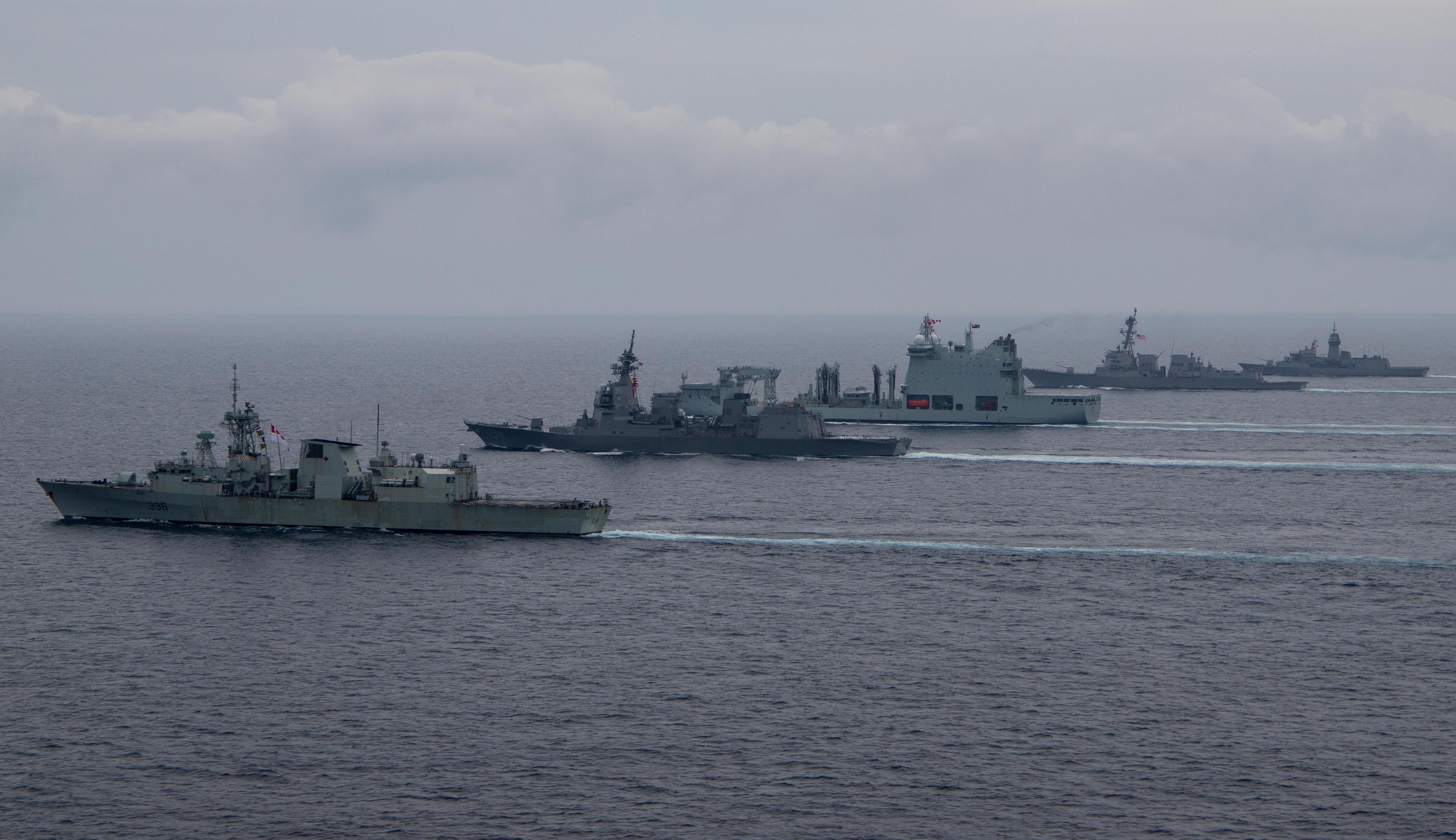
A joint Russian-People’s Liberation Army navy warship group docked at Qingdao, China on Monday. Meanwhile, the Philippines carried out a successful resupply of its outpost in the disputed Spratly Islands on Tuesday.
On Monday, a joint flotilla comprised of Russian Navy destroyers RFS Admiral Panteleyev (548) and RFS Admiral Tributs (564); corvette RFS Hero of the Russian Federation Aldar Tsydenzhapov (339); and fleet tanker Pechenga; and PLAN destroyers CNS Guiyang (119) and CNS Qiqihar (121); frigates CNS Zaozhuang (542) and CNS Rizhao (598); and fleet oiler CNS Taihu (889) docked into Qingdao. The corvette RFS Gremyashchiy (337) was part of the flotilla but has headed home to Russia. Gremyashchiy was tracked by Japanese forces transiting the Tsushima Strait from Friday to Saturday.
The flotilla has been sailing together on patrol since July 27 as part of the annual cooperative event by the Russian and Chinese militaries. This is the third joint patrol since the program started in 2021.
The commander of Admiral Tributs, Captain 2nd Rank Igor Tolbatov, told reporters that the flotilla had sailed as far as the Aleutian Islands, according to Russian state-controlled newswire Tass.
“This patrol was the longest and its first stage lasted a week. It was more intense, with combat exercises and joint maneuvering. Aircraft from both our side and the Chinese side carried out a large number of flights. Weather conditions were favorable and enabled us to accomplish all objectives safely and achieve excellent results. The second stage was lengthier. We sailed as far as Kamchatka, the Aleutian Islands and along the Pacific Ocean.” he said.
Earlier on Friday, the Russian Ministry of Defense said, “Ships of Russian and PLA navies are currently operating in the waters of the East China Sea and have covered more than 6,400 nautical miles since the beginning of the patrol. During this period, the sailors of the two countries have conducted anti-submarine exercises, trained to repel an air raid, carried out rescue training at sea, and improved their skills in taking off and landing helicopters on the decks of ships.”

Corvette Gremyashchiy, which was part of the flotilla when the patrol began, split off and headed for its homeport on Saturday, the Joint Staff Office (JSO) of Japan’s Ministry of Defense said. The JSO release stated that Japan Maritime Self Defense Force (JMSDF) multi-purpose support ship JS Amakusa (AMS-4303) and JMSDF P-1s Maritime Patrol Aircraft (MPA) of Fleet Air Wing 4 based at Naval Air Facility Atsugi on the main island of Honshu shadowed the Russian ship.
The JSO also said on Friday that two Russian IL-38 MPAs flew through the Tsushima Strait from the Sea of Japan and entered the East China Sea, then flew south before returning through the Tsushima Strait to the Sea of Japan. Fighters from the Japan Air Self Defense Force (JASDF) Western Air District were scrambled in response.
The JSO also issued a release on Monday stating that on Saturday at 4 a.m., the Russian surveillance ship Kurily (208) was sighted sailing east roughly 40 km southwest of Oshima Island, then sailed east through the Tsugaru Strait, which divides the Japanese main islands of Honshu and Hokkaido, to enter the Pacific Ocean.
Japan’s straits are international waterways. Japan allows foreign ships to pass through them, though the Japanese military shadows and reports on Russian and Chinese military ships transiting the straits. The JSO release stated that multipurpose support ship JS Suo (AMS-4302), minesweeper JS Izushima (MSC-687) and a JMSDF P-3C Orion of Fleet Air Wing 2 based at JMSDF Hachinohe Air Base shadowed the Russian ship.
Also near Japan, Exercise Noble Chinook, which involves the U.S., Canada and Japan, began on Monday in the northwest Pacific and will end on 28 August. USS Benfold (DDG-83) U.S. Coast Guard Cutter USCGC Kimball (WMSL-756) ; RCN frigates HMCS Vancouver (FFH331) and HMCS Ottawa (FFH341) and fleet oiler MV Asterix; and JMSDF helicopter destroyer JS Hyuga (DDH-181) are carrying out the exercise.
“Through the exercise, we improve our tactical capabilities and strengthen cooperation with the participating navies,” said Capt. Okishige Hiroki, commanding officer of Hyuga, in the release. “The exercise also demonstrates the will and the capability of Japan, allied and like-minded partners to maintain rules-based international order in order to realize a free and open Indo-Pacific.”
The RCN ships are beginning a five-month deployment to the Indo-Pacific, having left Canada on Aug. 14. Ottawa will focus on Southeast Asia, while Vancouver will focus on Northeast Asia. During its deployment, Vancouver will also help monitor the United Nations sanctions against North Korea as part of Operation NEON, the Canadian Armed Forces’ contribution to multinational monitoring efforts. Frigate HMCS Montreal (FFH336) has been deployed in the region since March but is now on the way home to Halifax, Canada with a scheduled arrival there in September.

Meanwhile, the Philippines on Tuesday carried out a successful resupply mission to the grounded tanker landing ship BRP Sierra Madre (LS-57) at Second Thomas Shoal in the disputed Spratly Islands. In a Tuesday statement, the Philippine National Task Force for the West Philippine Sea said that the resupply mission was conducted successfully “despite attempts by China Coast Guard (CCG) and Chinese Maritime Militia (CMM) vessels to block, harass, and interfere with the supply mission.” Philippine supply ships Unaizah May 1 and Unaizah May 2, escorted by Philippine Coast Guard (PCG) patrol vessels BRP Cabra (MRRV-4409) and BRP Sindangan (MRRV-4407) carried out the mission, according to the release.
“Routine missions to Philippine outposts on various features in the West Philippine Sea (WPS) will continue on a regular basis. These missions are part of the Philippine Government’s legitimate exercise of its administrative functions over the WPS, in line with the United Nations Convention on the Law of the Sea (UNCLOS), the 2016 Arbitral Award, and domestic laws” stated the release.
On Tuesday, the China Coast Guard (CCG) issued its own statement on the mission, saying that two repair ships and two coast guard ships from the Philippines entered the without the permission of the Chinese government and the CCG “issued stern warnings to Philippine ships, followed them all the way, and effectively regulated them.” The CCG statement said that, since the Philippines’ ships did not carry illegal building materials for large-scale reinforcement, the mission was allowed to proceed on the basis of humanitarianism.
“China has indisputable sovereignty over the Nansha Islands, including the Ren’ai Jiao [China’s name for the Spratlys and Second Thomas Shoal] and its adjacent waters, and firmly opposes the Philippine side taking the opportunity to ship illegal building materials to warships ‘grounded’ illegally. The China Coast Guard will continue to carry out rights protection and law enforcement activities in waters under China’s jurisdiction according to law,” concluded the statement.





